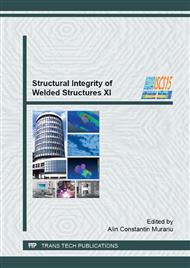[1]
C. Codrean, I. Mitelea, V.A. Şerban, Structural Morphology of Transformation by Vacuum Oven Brazed Joints with Amorphous Alloys, Advanced Materials Research, 2007, 23.
DOI: 10.4028/www.scientific.net/amr.23.221
Google Scholar
[2]
C. Codrean, V. A Serban, D. Utu, Amorphous and nanocrystalline alloys, VDM Verlag Dr. Mueller Aktiengesellschaft&Co. KG, (2009).
Google Scholar
[3]
C. Codrean, V.A. Serban, C. Stoian, New technology for stainless steels brazing with copper based amorphous alloys, BID-ISIM, Welding and Material Testing, Nr. 4/(2010).
Google Scholar
[4]
C. Codrean, V.A. Şerban, M. Burcă, B. Radu, Experiments Regarding Resistance Spot Brazing of Austenitic Stainless Steel With Amorphous Brazing Alloys, Welding in the World, 51, (2007).
DOI: 10.4028/www.scientific.net/msf.907.206
Google Scholar
[5]
N. DeCristofaro, D. Bose, Brazing and Soldering With Rapidly Solidified Filler Metals, Allied Metals Products Parsippany, NJ 07043, USA.
Google Scholar
[6]
L. Dorn, Hartlöten. Grundlagen und Anwendungen, Expert Verlag, (1985).
Google Scholar
[7]
A. Rabinkin, H. Liebermann, Brazing and Soldering Using RS Alloys, Chapter in a textbook Rapidly Solidified Alloys: Processes, Structures and Properties, and Applications, Ed. H.H. Liebermann, NY, (1993).
DOI: 10.1201/9781482233995
Google Scholar
[8]
A. Rabinkin, New Nickel-Chromium-based Amorphous Foil for Brazing Corrosion Resistant Heat Exchangers, 1996 BABS Conference.
Google Scholar
[9]
A. Rabinkin, E. Wenski, A. Ribando, Brazing Stainless Steel Using a New MBF-Series of Ni-Cr-B-Si Amorphous Brazing Foils, Welding Journal, Vol. 77, Nr. 2, (1998).
Google Scholar
[10]
R K. Roy, H. Bapari, A K Panda, A Mitra Development of high strength stainless steel brazed joints using rapidly solidified filler alloys, Volume 18, Issue 3 April (2013).
DOI: 10.1179/1362171812y.0000000081
Google Scholar
[11]
G. Sitte, Punktförmiges Widerstandslöten-Die Alternative zum Widerstandspunktschweiβen. Der Praktiker, 53, 2001, H. 5.
Google Scholar
[12]
V.A. Şerban, C. Codrean, D. Utu, C. Opriş, Amorphous alloys for brazing copper based alloys, Journal of Physics Conference Series 144, (2009).
DOI: 10.1088/1742-6596/144/1/012098
Google Scholar
[13]
X.W. Wu, Wide gap brazing of stainless steel to nickel-based superalloy, Journal of Materials Processing Technology 113, (2001).
DOI: 10.1016/s0924-0136(01)00596-9
Google Scholar
[14]
** Brazing Handbook, AWS, (1991).
Google Scholar


